

At the core of every obstacle is an opportunity. As the administrator for Mobile Giving Foundation Canada , I hear it all: the confusion, the struggles, the successes.

I hear about the “aha” moments and I hear about the missed opportunities too. Most frequently, I hear charities telling me about the obstacles they face that are unique to the mobile giving channel; obstacles that are not faced when using more traditional channels for donating. “Consent needed to contact donor!” “No personal donor information!” “Low donation amounts!” Dignitas International. Mathematical proof that "donor fatigue" isn't real.
One Email Tactic Nonprofits Need to Steal From Brand Marketers. Simply getting emails out the door can be a challenge for nonprofits.

Crafting relevant, interesting email on a regular basis? A nice idea, but near impossible for some nonprofits. Actually, it’s a common challenge for all email marketers. Sending the right message to the right constituent at the right time can be almost impossible to organize manually. 10 Ways to Improve Your Email Fundraising NOW. With online giving continuing to grow at a faster pace than giving overall according to the Blackbaud Index, it’s more important than ever for nonprofits to get serious about their online communications and fundraising strategies.
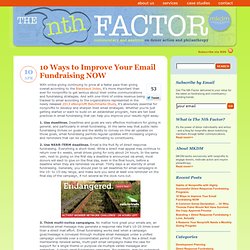
And with one-third of online revenue being tracked to email according to the organizations represented in the newly released 2013 eNonprofit Benchmarks Study, it’s absolutely essential for nonprofits to develop and sharpen their email strategies. Whether you’re just getting started or want to build on an established program, here are ten best practices in email fundraising that can help you improve your results right away: 1. Attention Nonprofit #datanerds: 3 Research Studies and 3 Cool (FREE) Data Tools. March is not only great for basketball, but is also good for nonprofit research studies about digital strategies and launches of new data tools.
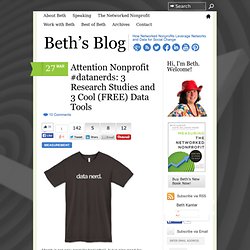
So if you like looking at and thinking about data and love to get your hands dirty with a data jujitsu, here’s a couple of goodies for you. 2013 eNonprofit Benchmarks Study Key Finding: Online nonprofit fundraising is on the rise, with explosive growth in sustaining gifts and a larger audience of supporters reached through social media networks like Facebook! The 2013 eNonprofit Benchmarks Study, conducted by M+R Strategic Services and NTEN, examines data from 55 nonprofits in sectors ranging from rights to environmental issues.
This year’s study – the seventh Benchmarks report – analyzes 1.6 billion email messages sent to 45 million list subscribers, 7.3 million advocacy actions, and more than $438 million online donations from over 6.5 million online gifts collected throughout 2012. Mention. Queen's School of Business - Voluntary Sector Reporting Awards - Free tools. Planned Giving—A great area for social media tools - Video Marketing Blog - MiniMatters - Video Production Washington DC. Planned giving—in which a donor gives a major gift in the context of financial or estate planning—is one of the best avenues for building donations for many nonprofits, currently representing 7-9% of charitable gifts.
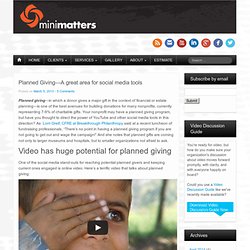
Annual reports: you don’t have to be big to be great. If annual reports dance through Patrick Johnston’s dreams, it would be understandable.
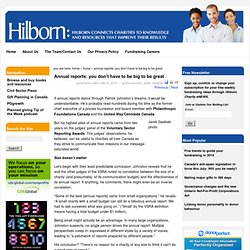
He’s probably read hundreds during his time as the former chief executive of a private foundation and board member with Philanthropic Foundations Canada and the United Way/Centraide Canada. But his highest piles of annual reports came from two years on the judges’ panel of the Voluntary Sector Reporting Awards. Tech ImpactTech Impact. There’s An App For That: Mobile Users Requiring More and More Attention. A strong web presence is paramount to maintaining a strong organization, and having a mobile-friendly web presence is increasingly an important element.

Currently, 85 percent of Americans own cell phones -- and more than half of those use them to access the Internet. Industry analysts expect browsing the web on mobile devices to become more common than browsing on traditional desktops and laptops as soon as next year. Idealware's research intern Tyler Cummins looked into the matter for the NonProfit Times, which originally published this article as a special report in its March 1, 2013, print edition.
Read it in its original format here. For organizations with a large number of constituents accessing their websites from mobile devices, those sites must be mobile-friendly -- in other words, as welcoming and useful to people viewing them on small smartphone screens as to those browsing on larger desktop monitors. You’re the One That I Want! How to Be Your Donors’ Favorite Cause. Toronto Net Tuesday: Why non-profit marketers and PR pros should give up movie night - Public Relations for Nonprofits - Karen Luttrell Communications. The Net Tuesday event had popcorn, was fun, and was far more informative than a typical movie night.
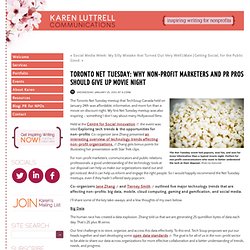
Perfect for non-profit communicators who want to better understand the tech at their disposal. Photo by Kozumel. The Toronto Net Tuesday meetup that TechSoup Canada held on January 24th was affordable, informative, and more fun than a movie on discount night. My first Net Tuesday meetup was also inspiring – something I don’t say about many Hollywood films. Held at the Centre for Social Innovation, the event was titled Exploring tech trends & the opportunities for non-profits. Your Nonprofit Tech Checklist. At the end of the Social Media for Social Good: A How-To Guide for Nonprofits is a nine-page “Nonprofit Tech Checklist” which I have copied and pasted below.

Each item on the list is discussed in the book and some items won’t make sense unless you have read the book, but most will. I hope you find it useful. That was my number one priority when writing the book… to create a comprehensive, useful social and mobile media how-to guide for nonprofits. Oh, and the book tour thus far has raised more than $14,000 for nonprofits. The IRS is still trying to wrap it’s head around that one… a book tour fundraiser. Getting Started: Organization and Planning. Strategies to Increase Nonprofit Donor Retention Rates. While all nonprofits recognize the value of cultivating donors over the long-term, they feel an incredible amount of pressure to implement short-term strategies that will raise money today.

Unfortunately, many nonprofits don't feel like they have the luxury of focusing on fundraising strategies that will bring in long-term results, which has led to low donor retention rates. According to the Fundraising Effectiveness Project, the commercial business customer retention rate is 94%. Guess what the nonprofit donor retention rate is? Beyond Like and Follow: Engaging Nonprofit Supporters Through Social Media. Facebook, Twitter & Pinterest are changing the face of supporter engagement and the road that leads to the most desirable form of participation—donations. So far, most nonprofits have responded to the challenge by including social media as just another outreach tool in a crowded kit that includes direct mail, PSAs, personal outreach, and more.
But social media isn't just another channel. It's a full-fledged platform for audience engagement that facilitates increasing levels of participation over a period of time—that is, if organizations can move beyond the paradigm of "like," "follow" "share" and "tweet," and begin building a brand experience that creates a deeper connection that allows nonprofits to innovate around their audience. Filling in the Gaps Many people in the nonprofit world have reasonable reservations about social media's effectiveness in fundraising based on the performance they've seen so far.
Take Facebook, for example. Katya's Non-Profit Marketing Blog. Wed, February 06 2013 Filed under: Fundraising essentials • At Network for Good, we found online giving once more on the rise in 2012. You can see the data illustrated via the 2012 Digital Giving Index infographic below, but one thing worth noting is this: donations made directly through nonprofit websites with branded giving pages raised six times more dollars than generic giving pages. Network for Good created the Digital Giving Index to provide insights and information on charitable engagement for both nonprofits seeking to strengthen relationships with donors and companies seeking engage with consumers and employees. This Index builds on data and observations from The Online Giving Study, released in 2010, and is updated quarterly to provide timely snapshots of the state of charitable giving.
Five Reasons Why Your Nonprofit Should Prioritize the Mobile Web in 2013. Yesterday’s free webinar entitled Five Reasons Why Your Nonprofit Should Prioritize the Mobile Web in 2013 was attended by 433 nonprofit professionals. To some, that may sound like a good turnout, but my free webinars usually hit the maximum of 1,000 attendees, so 433 was low – not surprising, however. In general, its been very difficult to get nonprofits to prioritize the Mobile Web. My blog posts on mobile technology are always the least trafficked, least retweeted, least liked and my regularly scheduled webinar on mobile communications and fundraising is the least attended of the entire series of ten webinars.
There are nonprofits out there boldly pioneering the Mobile Web, but unfortunately most nonprofits haven’t put much though into how their online communications and fundraising campaigns are affected by the rise of smartphones and tablets.